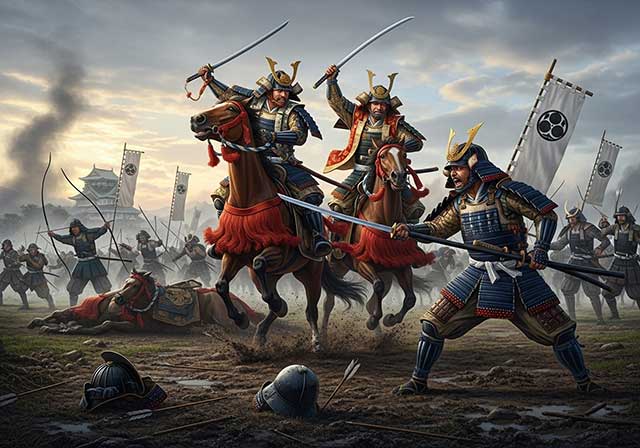
Hojo Ujiasu (1515–1571), one of the greatest representatives of the Hojo clan, spent almost his entire life at war. His possessions were in a difficult position: they were surrounded on all sides by aggressive neighbors ready to attack at any moment. In implementing his plans to expand the Hojo clan's influence in the Kanto region, Ujiasu was forced to confront well-known and powerful opponents—the Uesugi and Takeda clans. In the east, his main rival was the Satomi clan.
Confrontation with the Satomi clan
Satomi Yoshihiro (1530–1578) was the son of Satomi Yoshitaka, who was defeated by Hojo Ujitsuna, Ujiasu's father, in the first battle of Konodai in 1538. Fate decreed that, almost three decades later, the sons of these two great military leaders would meet in battle at the same place.
The battle
Initially, the campaign went well for Satomi Yoshihiro. He managed to capture Konodai Fort and drive out the Hojo clan's troops. Victory seemed close, and Satomi's troops were already ready to celebrate their success.
However, Ujiasu showed determination and composure: he regrouped his forces and gave the order to launch a new attack on the enemy army.
The attack came as an unpleasant and completely unexpected surprise to Yoshihiro's troops. Their battle order was disrupted, and many of Satomi's warriors were killed in the bloody clash. Yoshihiro himself had to flee and retreat to his own territory.
Ujiasu's son, Hojo Ujimasa, distinguished himself in this battle. His detachment managed to bypass the enemy's positions and strike the rear of Satomi's troops, which played an important role in the final outcome of the battle.
Consequences of victory
Having achieved success on the battlefield, Ujiasu attempted to develop his offensive. He invaded the provinces of Shimosa and Kazusa, hoping to finally crush the Satomi clan. However, he failed to completely destroy the enemy. Moreover, Hojo's movement to the east led to a clash with a new enemy, the Satake clan from the province of Hitachi. This circumstance halted further expansion.
Although the victory over Yoshihiro seriously weakened the Satomi clan's position, it was not destroyed. The Satomi continued to resist Hojo's influence for about ten more years.
Troop numbers
Sources differ in their estimates of the number of troops that took part in the second battle of Konodai. According to various data, Ujiasu's army numbered between 15,000 and 20,000 men. Yoshihiro's army was significantly smaller, numbering between 8,000 and 10,000 soldiers.
See also
-
The Siege of Hara Castle

The Shimabara Rebellion of 1637–1638, which culminated in the siege of Hara Castle, was the last major uprising of the Edo period and had serious political consequences.
-
Battle of Tennoji

The confrontation between Tokugawa Ieyasu and Toyotomi Hideyori during the “Osaka Winter Campaign” ended with the signing of a peace treaty. On January 22, 1615, the day after the treaty was signed, Ieyasu pretended to disband his army. In reality, this meant that the Shimazu forces withdrew to the nearest port. On the same day, almost the entire Tokugawa army began filling in the outer moat.
-
Siege of Shuri Castle

The Ryukyu Kingdom was established in 1429 on Okinawa, the largest island of the Ryukyu (Nansei) archipelago, as a result of the military unification of three rival kingdoms. In the following years, the state's control spread to all the islands of the archipelago.
-
The Siege of Fushimi Castle

Fushimi can perhaps be considered one of the most “unfortunate” castles of the Sengoku Jidai period. The original castle was built by Toyotomi Hideyoshi in the southeast of Kyoto in 1594 as his residence in the imperial city.
-
The Siege of Otsu Castle

The siege of Otsu Castle was part of the Sekigahara campaign, during which the so-called Eastern Coalition, led by Tokugawa Ieyasu, fought against the Western Coalition, led by Ishida Mitsunari. Otsu Castle was built in 1586 by order of Toyotomi Hideyoshi near the capital Kyoto, on the site of the dismantled Sakamoto Castle. It belonged to the type of “water castles” — mizujō — as one side of it faced Japan's largest lake, Lake Biwa, and it was surrounded by a system of moats filled with lake water, which made the fortress resemble an island.
-
The Siege of Shiroishi Castle

The siege of Shiroishi Castle was part of the Sekigahara campaign and took place several months before the decisive battle of Sekigahara. The daimyo of Aizu Province, Uesugi Kagekatsu, posed a serious threat to Tokugawa Ieyasu's plans to defeat the Western Coalition, and Ieyasu decided to curb his actions with the help of his northern vassals. To this end, he ordered Date Masamune to invade the province of Aizu and capture Shiroishi Castle.
-
The Second Siege of Jinju Castle

During the two Korean campaigns of the 16th century, the Japanese repeatedly had to capture enemy fortresses and defend occupied or constructed fortifications from the combined Korean and Chinese forces. Among all the operations of that time, the second siege of Jinju Castle is considered the most interesting from the point of view of siege warfare.
-
The Siege of Takamatsu Castle

The siege of Takamatsu Castle in Bitchu Province is considered the first mizuzeme, or “water siege,” in Japanese history. Until then, such an original tactic had never been used.

